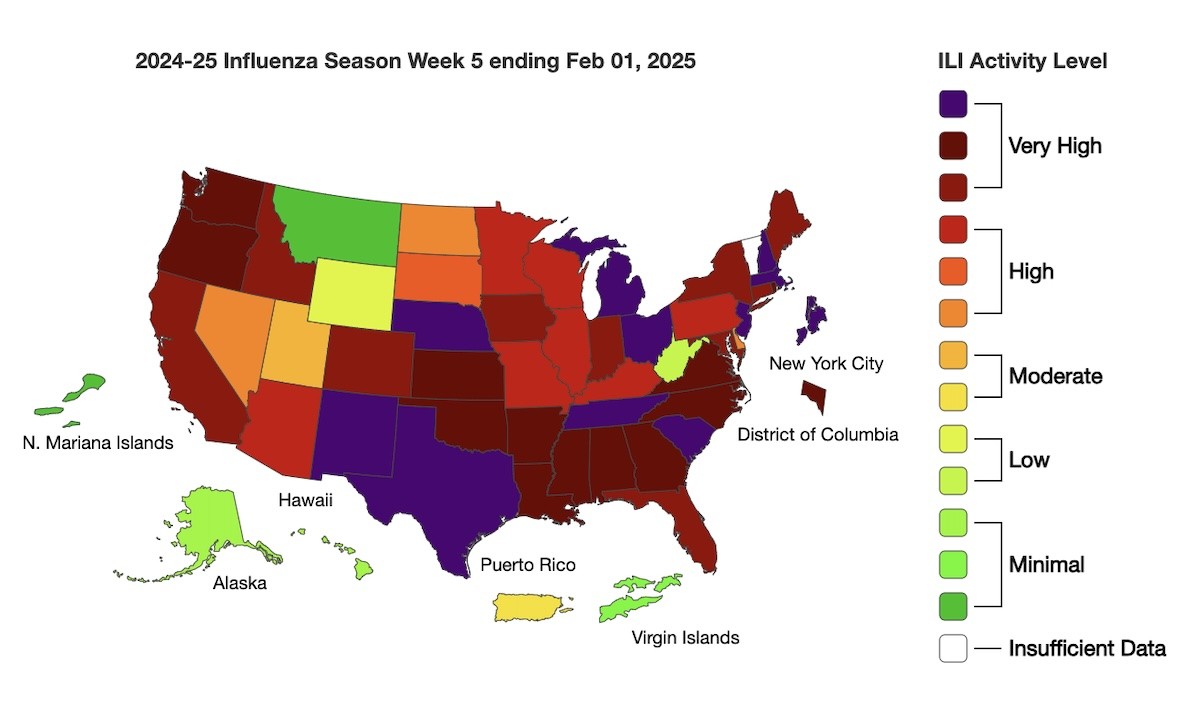It’s the Worst Flu Season in 15 Years—These States Are Getting Hit the Hardest

If you feel like everyone around you is sick… that’s because they are.
This winter is officially the worst flu season in 15 years. According to the Centers for Disease Control and Prevention (CDC), the percentage of doctor’s office visits for flu-like symptoms has surpassed any peak recorded since the 2009-2010 swine flu pandemic.
There are currently 43 states across the U.S. reporting high or very high flu activity, with some forcing to close schools and other public facilities. Here’s what to know about this season’s flu spread and where cases are surging so you can stay healthy and prepared.
RELATED: 7 Foods That Help Fight the Flu, Doctors Say
Flu Cases Are Surging Nationwide
According to the CDC’s latest report, released Friday, Feb. 7, Influenza A(H1N1)pdm09 and A(H3N2) were the predominant viruses reported during the week ending on Feb. 1, 2025.
So far this season, the CDC estimates there have been at least:
- 24 million flu illnesses
- 310,000 hospitalizations
- 13,000 deaths, including at least 57 children
In fact, according to an analysis conducted by NBC News, outpatient visits for flu-like symptoms are the highest they’ve been in 28 years.
And, emergency room visits have skyrocketed, according to those on the ground.
“My emergency room has been completely full for the last several weeks. There’s no inpatient beds, no ICU beds, and overflow (patients) are spilling into the emergency department. We have beds lining up and down every single one of the hallways,” Dr. Randy Joe Hartman, an emergency medicine physician at Baylor Scott & White Medical Center, told TODAY.com.
The Hardest-Hit States

The CDC’s latest data shows that the flu is spreading most aggressively across the South, Southwest, and Western states.
Texas, Louisiana, New Mexico, and California, in particular, are seeing some of the highest infection rates.
Other states struggling with severe outbreaks include:
- Florida – Hospitals are reporting a significant increase in flu-related ER visits, according to CNN.
- Tennessee – Schools are seeing widespread closures due to student and staff illnesses.
- Arizona – Health officials are warning of rising flu hospitalizations.
- New York – Pediatricians report an influx of flu cases, especially among children.
The CDC has a full list of all 50 states and their latest U.S. State and local influenza information.
RELATED: 7 Best Supplements to Boost Your Immunity
How to Protect Yourself
No age group is immune to this season’s widespread flu, as Hartman told TODAY.com. He said that while flu is the primary concern, RSV and COVID-19 are still circulating, adding more strain to hospitals.
With months to go before flu season ends (this one started later than usual, officials say), it’s best to stay vigilant. Only 44% of Americans received a flu shot this year—the same amount as last year. Vaccination rates for children have also dropped from 50% to 45%.
The CDC recommends that everyone ages 6 months and older get an annual flu vaccine. Once infected, there are prescription flu antiviral drugs that can treat the illness, which should be prioritized for those at higher risk of illness and should be started as early as possible. Higher risk individuals include adults over 65, children under the age of two, pregnant wome,n and those with weakened immune systems or underlying conditions.
Other important precautions you and your family can take during daily life:
- Wash your hands frequently. Use soap and water to prevent the spread of germs.
- Avoid touching your face. Flu viruses enter through the eyes, nose, and mouth.
- Disinfect commonly touched surfaces. Regularly clean doorknobs, countertops, and personal devices.
- Stay home if sick. As we all learned during the COVID-19 pandemic, you should limit contact with others to prevent spreading the virus.